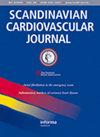主动脉瓣置换术后6个月和12个月患者健康相关生活质量的改善
IF 1.2
4区 医学
Q3 CARDIAC & CARDIOVASCULAR SYSTEMS
引用次数: 1
摘要
抽象目标。当评估心脏手术的主观结果时,生活质量(QoL)可能是患者最重要的变量。本研究的目的是分析主动脉瓣置换术(SAVR)后1年生活质量的变化。设计2013年至2018年进行了一项芬兰单中心前瞻性队列干预研究。术前、术后6天和术后12天采用EQ-5D-3L VAS问卷评估生活质量 手术后数月。我们使用单变量分析来评估出现问题的人数的变化,并使用逻辑回归分析来评估患者的生活质量变化特征。后果在一年的随访中,患者的生活质量在所有EQ-5D维度上都有所改善。出现问题的患者人数减少最多12 手术后几个月,在“移动性”维度上发生了变化(报告问题的变化为-24.1%,p < .01),“自我照顾”(-32.9%,p < .01)和“疼痛或不适”(-25.7%,p < .01)。术前EQ视觉模拟量表(VAS,从0到100)的平均值为63.0(SD 17.7,n = 604)和12 术后81.2个月(SD 13.8,n = 367页 < .001)。在多变量分析中,术前肥胖与“日常活动”中更好的生活质量相关(OR 3.39,95%CI 1.007-11.439),患者较高的手术风险与术后更好的“自我护理”相关。结论。SAVR可以在EQ–5D和自评整体健康(VAS)的所有维度上提高1年的生活质量。本文章由计算机程序翻译,如有差异,请以英文原文为准。
Improved health-related quality of life in patients 6 and 12 months after surgical aortic valve replacement
Abstract Objectives. Quality of life (QoL) is possibly the most important variable for the patient when subjective results of heart procedures are evaluated. The purpose of this study was to analyze the change in the quality of life 1 year after surgical aortic valve replacement (SAVR). Design. A Finnish single-center prospective cohort intervention study was performed from 2013 to 2018. QoL was assessed with the EQ-5D-3L VAS questionnaire before surgery and 6 and 12 months after surgery. We used univariate analysis to assess the change in the number of people experiencing problems and logistic regression analysis to assess the patients’ characteristics on the change in QoL. Results. At one year follow-up, patients’ quality of life improved in all EQ-5D dimensions. The greatest decreases in patients experiencing problems 12 months after surgery occurred in the dimension “mobility” (–24.1% change in reporting problems, p < .01), “self-care” (–32.9%, p < .01), and “pain or discomfort” (–25.7%, p < .01). Before surgery mean of EQ visual analogue scale (VAS, from 0 to 100) was 63.0 (SD 17.7, n = 604), and 12 months after surgery 81.2 (SD 13.8, n = 367, p < .001). In multivariable analysis, preoperative obesity was associated with better quality of life (OR 3.39, 95% CI 1.007–11.439) in “daily activities” and patients’ higher operative risk was associated with better “self-care” after surgery. Conclusions. SAVR can improve the 1-year quality of life in all dimensions of EQ–5D and self-rated overall health (VAS).
求助全文
通过发布文献求助,成功后即可免费获取论文全文。
去求助
来源期刊

Scandinavian Cardiovascular Journal
医学-心血管系统
CiteScore
3.40
自引率
0.00%
发文量
56
审稿时长
6-12 weeks
期刊介绍:
The principal aim of Scandinavian Cardiovascular Journal is to promote cardiovascular research that crosses the borders between disciplines. The journal is a forum for the entire field of cardiovascular research, basic and clinical including:
• Cardiology - Interventional and non-invasive
• Cardiovascular epidemiology
• Cardiovascular anaesthesia and intensive care
• Cardiovascular surgery
• Cardiovascular radiology
• Clinical physiology
• Transplantation of thoracic organs
 求助内容:
求助内容: 应助结果提醒方式:
应助结果提醒方式:


